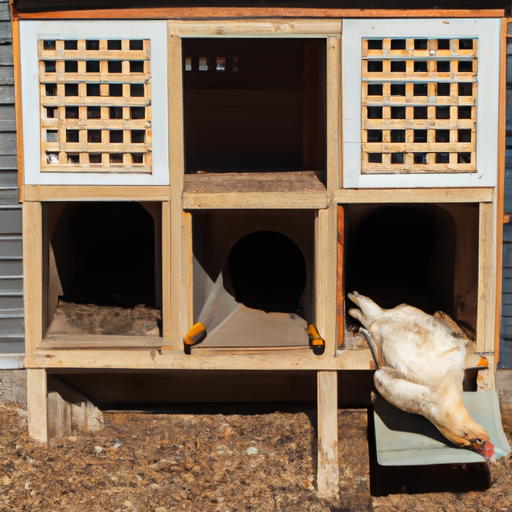So, you’ve decided to venture into the world of backyard chicken keeping and are ready to embark on the exciting journey of selecting and setting up your very own beginner-friendly chicken coop. But with so many options available, it can be a daunting task to make the right choice. Fortunately, this article is here to guide you through the process, offering valuable tips and insights to ensure you find the perfect chicken coop that will provide a comfortable and safe home for your feathery friends. From sizing considerations to important features, we’ll cover everything you need to know to make the best decision for both you and your new flock. Let’s get started!
Choosing the Right Chicken Coop
Consider the Size of the Coop
When choosing a chicken coop, it’s important to consider the size of the coop in relation to the number of chickens you plan to have. You want to ensure that your chickens have enough space to move around comfortably and have access to their nesting boxes and perches. A general rule of thumb is to allow 2-4 square feet of coop space per chicken. However, if you have larger breeds or if you plan to keep your chickens confined to the coop for longer periods of time, you may want to provide a bit more space.
Evaluate Your Available Space
Before purchasing a chicken coop, take the time to evaluate the available space in your backyard or homestead. Consider the dimensions of the coop and make sure it will fit comfortably in your desired location. Also, think about the layout of your property and how the chicken coop will fit into your overall plan. You want to ensure that the coop is easily accessible for cleaning, feeding, and general maintenance.
Check the Coop Material and Design
Chicken coops come in a variety of materials and designs, each with its own advantages and disadvantages. The most common materials for chicken coops are wood, plastic, and metal. Wood is a popular choice for its natural and aesthetically pleasing appearance, but it may require more maintenance over time. Plastic coops are often lightweight and easy to clean, but they may not be as durable. Metal coops are sturdy and provide good protection against predators, but they can be more expensive. Consider the pros and cons of each material and choose one that best suits your needs.
Think about the Mobility of the Coop
If you plan to move your chicken coop around your property, consider choosing a coop with wheels or a design that allows for easy mobility. This can be particularly useful if you have limited space or if you want to fertilize different areas of your garden with your chickens’ manure. However, keep in mind that not all chicken coops are designed for mobility. Make sure to choose one that has the features you need.
Consider Your Weather Conditions
Your local weather conditions should also be taken into account when choosing a chicken coop. Some coops come with built-in insulation or ventilation systems that can help regulate the temperature inside the coop. This is especially important if you live in an area with extreme heat or cold. Additionally, consider the amount of rain or snow your area receives and choose a coop that is weather-resistant to keep your chickens dry and comfortable.
Setting Up the Chicken Coop
Selecting the Location
Choosing the right location for your chicken coop is crucial for the well-being of your flock. It should be an area that provides shade in the summer and protection from wind and rain. Ideally, the coop should also have access to plenty of natural sunlight. Keep in mind that chickens need a safe and secure environment, so place the coop away from potential predators and ensure that the surrounding area is free from hazards.
Preparing the Ground
Before setting up your chicken coop, it’s important to prepare the ground to ensure a safe and healthy environment for your chickens. Clear any debris, rocks, or vegetation that may be on the ground. Level the area if necessary and consider adding a layer of gravel or sand to promote drainage. This will help prevent standing water, which can attract pests and lead to unsanitary conditions.
Ensuring Proper Ventilation
Good ventilation is essential for the health and comfort of your chickens. It helps control humidity, prevent the buildup of ammonia, and remove stale air. Make sure your chicken coop has adequate ventilation openings, such as windows or vents. You can also install a fan or use vents with adjustable covers to regulate air circulation. Just be sure to protect the vents with wire mesh to prevent predators from entering.
Providing Light and Heat
Chickens require natural light to maintain their circadian rhythm and lay eggs regularly. When setting up your coop, ensure that it receives enough natural sunlight or install artificial lighting to supplement if needed. In colder climates, consider adding a heat source to keep the coop warm during winter. This can be a heat lamp or a heated perch. Be mindful of fire hazards and follow safety guidelines when using heat sources.
Installing Nesting Boxes and Perches
Nesting boxes provide a comfortable and private space for your chickens to lay their eggs. Install nesting boxes in a quiet corner of the coop and line them with soft bedding material, such as straw or wood shavings. Perches are also crucial as they give your chickens a place to roost and rest. Install perches at varying heights to accommodate different sizes and breeds of chickens. Make sure they are secured firmly to avoid injuries.
Creating a Safe Environment
Fencing the Coop
Fencing is essential to keep your chickens safe and secure within their coop and run. Choose a sturdy fencing material that can withstand attempts from predators to break in. Chicken wire is a common choice, but it may not be sufficient to keep out determined predators. Consider using hardware cloth with smaller openings for added security. Ensure that the fence is buried at least a foot underground to prevent predators from digging underneath.
Protecting against Predators
Predators pose a significant threat to your flock, so it’s important to implement measures to protect your chickens. Install predator-proof latches on the coop doors and windows to prevent them from being easily opened. Consider adding a predator-proof apron around the perimeter of the coop, which is an outward-facing skirt of fencing that prevents predators from digging in. Finally, consider using motion-activated lights or even a guard dog to deter nocturnal predators.
Preventing Disease and Parasites
Maintaining the health of your flock is crucial for their well-being and productivity. Regularly clean and disinfect the coop to prevent the buildup of bacteria and parasites. Provide clean bedding material, such as straw or wood shavings, and regularly replace it to prevent the spread of disease. Additionally, practice good biosecurity measures, such as limiting visitors and quarantining new chickens, to prevent the introduction of diseases.
Maintaining Cleanliness
A clean coop is essential for the health and happiness of your chickens. Regularly remove soiled bedding and waste from the coop to prevent the buildup of harmful bacteria and odors. Use a rake or shovel to remove any debris or spilled feed. Additionally, periodically wash the interior of the coop with a mild detergent and water, ensuring it is thoroughly dried before reintroducing the chickens.
Providing Food and Water
Ensure that your chickens have access to fresh food and water at all times. Install a feeder inside the coop and a waterer that is easy to clean and refill. Protect the feeder from pests by using a hang or treadle feeder that can be raised off the ground. Provide a separate source of water outside the coop for your chickens to drink from during free-ranging.
Choosing the Right Chicken Breed
Deciding on Purpose (Eggs, Meat, or Both)
Before choosing a chicken breed, consider your purpose for keeping chickens. If you primarily want a steady supply of eggs, focus on breeds known for their high egg-laying capacity, such as Leghorns or Rhode Island Reds. If you plan to raise chickens for meat, look for meat-specific breeds, such as Cornish Cross or Jersey Giants. Some breeds, like Australorps or Plymouth Rocks, are known for being dual-purpose, meaning they are suitable for both eggs and meat.
Considering Climate Adaptability
Different chicken breeds have varying levels of adaptability to different climates. Some breeds are more cold-hardy and can tolerate colder temperatures, while others are better suited for warmer climates. Research the climate adaptability of different breeds and choose one that can thrive in your local climate. You may also need to provide additional protection or shelter for chickens that are not well-suited to your climate.
Evaluating Temperament
Chicken breeds can have different temperaments, ranging from docile and friendly to more skittish or flighty. Consider the temperament of the breed you are interested in and choose one that fits your preferences. If you have children or plan to interact with your chickens frequently, look for breeds known for being calm and friendly. However, keep in mind that individual chickens can have their own personalities, so it’s important to handle and socialize them from a young age.
Researching Egg-laying Capacity
If you are primarily interested in egg production, it’s important to research the egg-laying capacity of different breeds. Some chickens lay eggs consistently year-round, while others may only lay during certain seasons or have a lower overall egg production. Take into account the breed’s average egg size, shell color, and frequency of laying when making your decision. Keep in mind that individual factors, such as diet and age, can also affect egg production.
Assessing Cost and Availability
The cost and availability of different chicken breeds may vary depending on your location. Some rare or exotic breeds may be more expensive and harder to find, while common breeds can be more affordable and readily available. Consider your budget and the availability of different breeds in your area. It’s also worth considering purchasing from reputable breeders or hatcheries to ensure the health and quality of your chickens.
Bringing Your Chickens Home
Deciding on Baby Chicks or Adult Birds
When bringing chickens home, you have the option of starting with baby chicks or adult birds. Baby chicks require more care and attention, including a brooder setup with a heat source, but they also offer the opportunity to raise them from a young age and bond with them. Adult birds, on the other hand, require less intensive care but may take longer to adapt to their new environment. Consider your level of experience and the time and resources you can dedicate to care.
Preparing a Temporary Brooder
If you decide to start with baby chicks, you’ll need to set up a temporary brooder until they are old enough to transition to the coop. A brooder should be warm, safe, and provide enough space for the chicks to move around. Use a large plastic bin or a dedicated brooder box and line the bottom with clean bedding material, such as pine shavings. Provide a heat source, such as a heat lamp or heating pad, to keep the chicks warm.
Introducing the Chickens to Coop and Run
Once your chickens are old enough and have acclimated to their brooder, it’s time to introduce them to the coop and run. Start by allowing them supervised access to the coop and run during the day, gradually increasing their time outside. This helps them familiarize themselves with their new surroundings and establishes the coop as their new home. Ensure that the coop and run are secure and predator-proof before allowing the chickens full access.
Monitoring Chickens’ Health
Regularly monitor the health and well-being of your chickens to ensure they remain happy and disease-free. Check for any signs of illness, such as lethargy, loss of appetite, or changes in behavior. Inspect their feathers, feet, and eyes for any abnormalities, and regularly check for external parasites, such as mites or lice. If you notice any concerning symptoms or issues, seek advice from a veterinarian experienced in chicken care.
Establishing a Routine
Chickens thrive on routine, so establishing a consistent daily routine is important for their well-being. Set specific feeding times and provide fresh food and water each day. Check for eggs and collect them promptly to prevent any damage or egg-eating behavior. Clean the coop regularly, keeping an eye out for any signs of pest infestations. By sticking to a routine, you provide your chickens with a sense of security and help maintain their overall health.
Conclusion
Choosing and setting up a beginner-friendly chicken coop involves careful consideration of factors such as size, available space, coop materials, and weather conditions. Additionally, creating a safe and comfortable environment, selecting the right chicken breed, and properly introducing your chickens to their new home are all crucial steps in ensuring the health and happiness of your flock. By following these guidelines and maintaining a regular routine, you can embark on a rewarding and enjoyable journey of raising backyard chickens. Happy chicken keeping!




